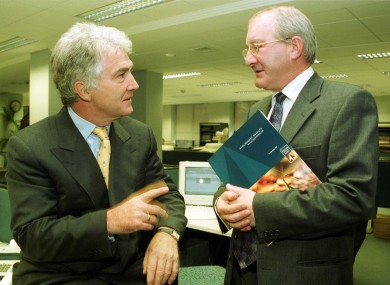Sean FitzPatrick is to go on trial for under-declaring loans by €139m


FORMER ANGLO IRISH CHAIRMAN AND CHIEF EXECUTIVE SEAN FITZPATRICK HAS BEEN RETURNED FOR TRIAL ACCUSED OF HIDING THE TRUE VALUE OF MULTI-MILLION EURO LOANS FROM AUDITORS OF THE TOXIC BANK.
Boxes of evidence were served by a fraud squad detective in a Dublin court yesterday morning as Mr FitzPatrick was sent forward for trial on 12 counts of breaking company law.
Now bankrupt, he has not yet indicated how he will plead. He will remain on bail, but was told he cannot leave the country unless he gives 48 hours’ notice to gardai.
Mr FitzPatrick, who will be tried on indictment before a jury at Dublin Circuit Criminal Court, will face his next hearing on March 22, Judge Patricia McNamara ordered. It is likely that it will be several months before the trial gets under way.
The former banker was charged last December 21 at Dublin District Court with 12 counts in connection with financial irregularities at Anglo over a six-year period.
Misleading: Mr FitzPatrick, of Whitshed Road, Greystones, Co Wicklow, stepped down in December 2008 and left with a €3m pension pot. Anglo was subsequently nationalised and rebranded the Irish Bank Resolution Corporation (IBRC), with its collapse costing Irish taxpayers around €30bn.
In this set of proceedings, Mr FitzPatrick is accused of committing 12 offences contrary to the Companies Act.
He faces six counts stating that as an officer of the bank he knowingly or recklessly made false, misleading or deceptive statements to Anglo’s auditors, Ernst & Young, between 2002 and 2007 by under-declaring the balance on loans by at least €139m.
He also faces six more charges for failing to disclose an arrangement between Anglo and Irish Nationwide under which the building society loaned him money between 2002 and 2007.
If convicted, he could face fines of up to €12,697 and/or a maximum sentence of up to five years in prison for each offence.
The 64-year-old had replied “no comment” to each count when he was charged in December, when he was remanded on bail to appear again yesterday at Dublin District Court where the case was listed for the State to serve him with a book of evidence – it turned out to be boxes of evidence.
IP-TSB raises €400m in deal secured against its UK portfolio


STATE-OWNED PERMANENT TSB (PTSB) BORROWED €400M THIS WEEK, RAISING THE CASH IN A DEAL SECURED AGAINST A SHARE OF ITS STOCK OF UK MORTGAGES.
Permanent TSB is the last of the bailed-out banks that is still not borrowing on the bond markets, but the recent deal shows it can raise cash from private deals where UK mortgage assets are pledged as security.
The latest deal brings to €1bn the amount of new debt raised by the bank so far this year. The bank has raised €3.6bn this year when refinancing of some debt is included.
Financial details, including the cost of the new borrowing have not been revealed, but the banks says the debt is being raised at market rates.
Last week ratings agency Moody’s downgraded PTSB, citing “uncertainty and risks”, to B3 from B1.
Losses
PTSB became the last and smallest of the Irish-owned bank to survive the banking crisis after the EU and IMF approved the Government’s decision not to shut it down last year.
Earlier this year the bank announced its intention to dramatically increase lending including for home loans in 2013 for the first time since the property crash.
Meanwhile, the UK-based Lloyds Banking Group said it set aside £1.2bn (€1.4bn) to cover loan losses in Ireland last year, just a third of the amount set aside in 2011.
The loans are mainly a legacy of Lloyds’ takeover of Bank of Scotland (Ireland), which no longer does business here but was a major lender during the property bubble.
Lloyds said the pace of new impairments on Irish loans has slowed to 1.6pc in 2012 from 4.1pc a year earlier.
The bank has a reputation for dealing with its Irish losses.
Last year it sold €1.8bn of Irish property loans for just €149m to US investor Apollo Global Management.
IRELAND’S MANUFACTURING GROWTH INCREASES IN FEBRUARY


Growth in the country’s manufacturing activity recovered from a nine-month low in February, extending the expansion in the sector to 12 months even as most of the Eurozone continues to contract, a survey showed yesterday.
The economy returned to growth in 2011, while the slump seen elsewhere in the Eurozone likely saw the export-led expansion slow to just 0.9% last year.
In February, the NCB Manufacturing Purchasing Managers’ Index rose to 51.5 from 50.3 in January, back to the level of growth seen at the end of last year, and well above the 50 line that divides expansion from contraction.
According to World Bank figures, manufacturing contributes around one quarter of Ireland’s gross domestic product.
The growth here stands in stark contrast to the contraction in factory activity for the eurozone as a whole, as seen in flash PMI data.
February’s rise was driven by a return to growth in new orders, which had slipped into negative territory for the first time in a year in January, while new export orders also climbed, albeit marginally, for a fifth successive month.
The positive momentum also filtered through to the number of new jobs in the sector, with the subindex measuring employment up to 52.7 from 49.6 in January, when it contacted for the first time in 11 months.
“Encouragingly, the improvement was partly attributed to expectations of higher production requirements over the coming months,” Philip O’Sullivan, chief economist at NCB Stockbrokers, said of the bump in employment.
“In all, with the headline PMI reading pointing to a 12th successive month of growth for the Irish manufacturing sector, and the rate of expansion improving from the nine-month low in January, this is a solid outturn.”
Data released this week showed the unemployment rate here fell to 14.2% in the fourth quarter of last year, a more than two-year low.
Plans for reducing the Government debt set to peak above 120% of gross domestic product this year depend on the domestic side of the economy improving from next year and GDP growth accelerating to above 2% in 2015.
The five most deadly parasites that affect 200,000 people worldwide

We’ll be doing something special on this week’s Future-proof – some very special guests will be joining us to discuss this week’s announcement of the first planned manned mission to Mars – but we’ll also be talking parasites with Phillip Newmark from the University of Illinois. Phillip’s group has just published a paper on Schistosoma mansoni, the blood fluke.
These parasites affect over 200 million people worldwide… they also ave incredible regenerative properties. Jonathan will be speaking to Phillip about the stem cells that make this possible and the lifecycle of these strange parasites. In the meantime, here are five of the weirdest parasites we could find:
The Horsehair Worm:
Fortunately the Horsehair Worm only attacks insects. It infiltrates its host through contaminated water and will then fester its way through the body cavity. After it had grown to a foot long, it will go in search of a mate. It does this by confusing the host into thinking that it’s thirsty, before drowning it in the nearest contaminated water source it can find before escaping through its anus.
The Guinea Worm:
As thick as a noodle and almost one metre long. Its eggs can be found in contaminated water and when ingested, travels under the skin and resurfaces through a blister which can be excruciating for the host. It must be slowly teased out over a number of weeks.
The Entomophthora Fungus:
Another parasite that attacks the brain. This fungus can be found in the common housefly and is consumed through the ingestion of contaminated food. It takes residence in the fly and begins to eat it alive from the inside for almost a week. Just before it is about to die, it tricks the host by making it fly to a height where it explodes and trickles down onto a new one.
The Botfly:
Infested within the mosquito, it gets passed onto the human host as a tiny maggot and burrows itself through the skin. It remains there and feeds off muscle tissue for eight weeks before making its escape through the same hole.
Schistosomes:
These parasitic flukes live in the bloodstream of humans and mainly children. Originally they develop in urine and faeces and infect snails. Once they have grown, they emerge and attack a human host by burying under the skin. It is common in developing countries where there is poor sanitation and currently infects over 200 million people.
Fishing is pushing sharks closer to extinction


A new study estimates that commercial fishing kills 100 million sharks annually
Commercial fishing kills roughly 100 million sharks a year, a toll that is pushing many of species of the fish closer to extinction, according to a study published Friday in the journal
The analysis, based on a survey of roughly 100 papers, suggests that despite several efforts to curb shark finning worldwide, the total number of shark deaths has declined only slightly between 2000 to 2010, from 100 million to 97 million.
“It is not sustainable,” said Dalhousie University biology professor Boris Worm, the paper’s lead author, noting that sharks have roamed the seas for more than 400 million years. “Imagine we still had 500 species of dinosaurs around — every form and color from tiny critters to huge,whalelike creatures. Once they were everywhere, but then we started to chop off their tails to make soup from it, and now they are going extinct — not because a meteorite hit the planet, but because we ate their tails.” Elizabeth Wilson, manager of global shark conservation at the Pew Environment Group, said she hoped delegates to the Convention on International Trade in Endangered Species of Wild Fauna and Flora (CITES) over the next two weeks would act on the findings and restrict the trade of oceanic whitetip, porbeagle and three types of hammerhead sharks. “The number of sharks being killed is too high,” Wilson said. “There’s an opportunity at CITES to do something to help shark species.”

No comments:
Post a Comment